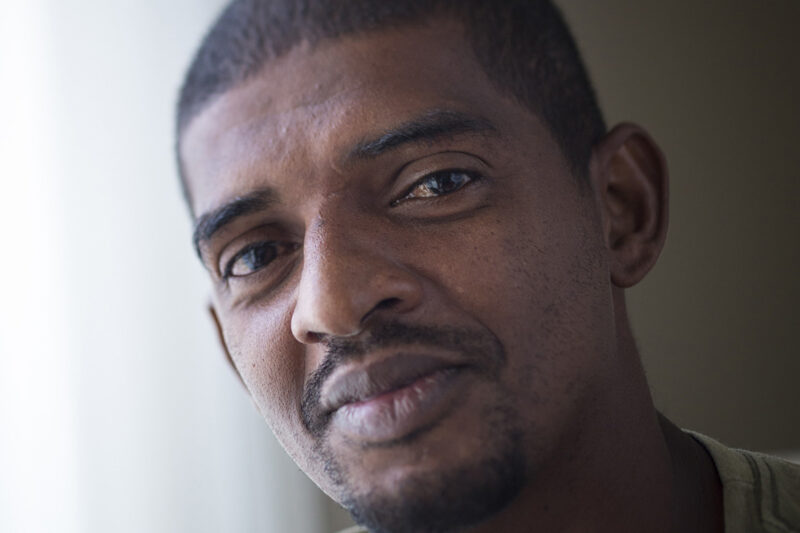‘The Darkness Comes’: CIA Torture Victims Describe How the Mental Scars Never Go Away


The New York Times is publishing a devastating exposé on the lasting psychological effects of U.S. government torture on men who once were held in CIA-run secret overseas prisons or at Guantanamo Bay.
Two psychologists, James Mitchell and Bruce Jessen, were independent contractors for the CIA and designed and helped implement the torture program. They are now defendants in an ¿œ∞ƒ√≈ø™Ω±Ω·π˚ lawsuit on behalf of three of those victims. Two of them were interview for the Times series ‚Äî the third was tortured to death.
The psychologists based the torture program on junk science claiming that abusing prisoners until they reached a state of “learned helplessness” would lead to accurate intelligence. Since the program was ended, there has been no meaningful accountability for its perpetrators nor redress for its victims.


%3Ciframe%20allowfullscreen%3D%22%22%20frameborder%3D%220%22%20height%3D%22326%22%20src%3D%22https%3A%2F%2Fwww.youtube.com%2Fembed%2Fl52sqgBCt4Q%3Fautoplay%3D1%26version%3D3%22%20thumb%3D%22%2Fsites%2Fdefault%2Ffiles%2Ffield_image%2Fweb16_darkness-ciaagents-580x326.jpg%22%20width%3D%22580%22%3E%3C%2Fiframe%3E
Privacy statement. This embed will serve content from youtube.com.
One of the stories the Times series is that of our client Mohamed Ahmed Ben-Soud. In 2003, he was kidnapped in his country of Libya and unlawfully rendered to the Salt Pit, a secret CIA prison, which he and other detainees call “The Darkness.”

There, Ben Soud was subjected to some of the worst tortures of the Mitchell-Jessen devised program. He was “forced onto a plastic tarp while naked, his hands shackled above his head,” while CIA officials “poured buckets of ice water on him as others lifted the tarp’s corners, sending water splashing over him and causing a choking or drowning sensation.” He was locked inside coffin-sized boxes, some even smaller; slammed repeatedly against a wall; and chained to the ceiling by his arms for days. Rock music blasted deafeningly throughout the pitch black dungeon where he was held and tortured and abused for a year.
Unsurprisingly, Ben-Soud has not recovered from the trauma of his time in “The Darkness.” Today, he lives “in constant fear of tomorrow.” And, when his children ask why he loses his temper so suddenly, he told the Times, he is at a loss for words: “How can you explain such things to children?”
Another ¿œ∞ƒ√≈ø™Ω±Ω·π˚ client, Suleiman Abdullah Salim, was the subject of the . After his abduction by the CIA and the Kenyan government, Salim too was sent to ‚ÄúThe Darkness‚Äù and brutally tortured.
He was held in solitary confinement in a room so dark “he could not see the shackles on his arms or the walls of his cell.” He was hung from the ceiling by his arms, slammed into a wall, doused in ice-cold water and wrapped in a tarp, repeatedly beaten, and stuffed inside a “coffin-like box.”
Eight years after his release, Salim remains deeply traumatized. He has been diagnosed with lasting psychological injuries from his torture, including severe depression and post-traumatic stress disorder. He experiences frequent nightmares and terrifying flashbacks, frequent spells of dizziness and confusion, and major depression.
“Many times now I feel like I have something heavy inside my body,” Salim told The Times. “Sometimes I walk, and I walk, and I forget, I forget everything, I forget prison, The Darkness, everything. But it is always there. The Darkness comes.”


%3Ciframe%20allowfullscreen%3D%22%22%20frameborder%3D%220%22%20height%3D%22326%22%20src%3D%22https%3A%2F%2Fwww.youtube.com%2Fembed%2FRIGQR3apPkU%3Fautoplay%3D1%26version%3D3%22%20thumb%3D%22https%3A%2F%2Fwww.aclu.org%2Fsites%2Fdefault%2Ffiles%2Fweb15-dem-hererainfinishes-580x326.jpg%22%20width%3D%22580%22%3E%3C%2Fiframe%3E
Privacy statement. This embed will serve content from youtube.com.
While many think of torture as only physical violence, the effects of which end after the wounds are treated, the Times series is a reminder that the long-lasting mental trauma associated with torture can be even worse. In the case of U.S. torture, these traumas have been exacerbated by a complete lack of redress for victims.
As the Times editorial board in a commentary on the series, “The question now is whether anyone will be held to account for the damage wrought by one of the most depraved periods in American history.” President Obama’s stance on torture accountability has been to move on from the Bush administration’s atrocities. However, Salim, Ben-Soud, and others — haunted every day by the traumas inflicted on them — are unable to move on.
Unlike other lawsuits seeking accountability for CIA torture, the judge in our case against the psychologists is allowing the litigation to move forward, which the editorial noted could present “the first-ever opportunity for the justice system to reckon directly with the brutal legacy of the government’s torture policies.”
With another ruling Friday a lawsuit by tortured inmates of Iraq’s Abu Ghraib prison against a U.S. military contractor, some measure of justice is getting closer for at least some victims of U.S. torture.
Accountability is critical not just for survivors, victims, and their families. It is also critical for all of us who value living in a nation of laws, one strong enough to acknowledge wrongdoing and make amends.
Only by fully reckoning with the past can our clients, the hundreds of others just like them, and our country finally move on with confidence that it will never happen again. And leading up to an election in which torture is being floated as an official policy option, it’s as necessary as ever.

